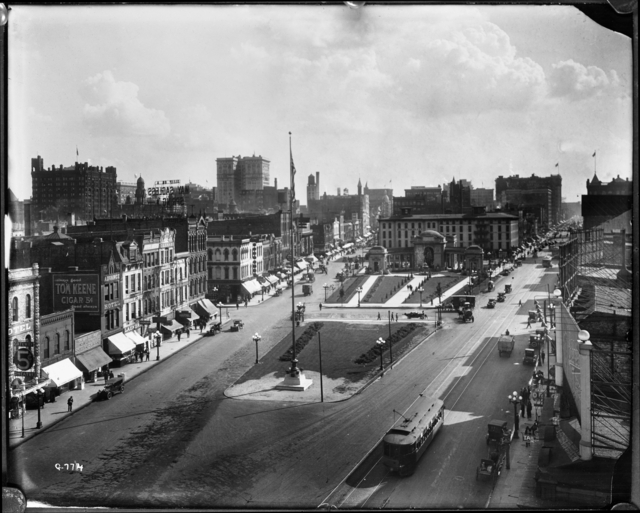The Gateway District was Minneapolis’ original downtown, where life revolved around mills and railroads. As aging buildings became boarding houses for the thousands of temporary workers who spent their off-seasons in Minneapolis, the neighborhood gained a seedy reputation and the nickname “Skid Row.” The twenty-five-block zone was targeted for decades by mission workers, city planners, and police as a hub of vice and firetrap buildings, but the redevelopment of the area failed to mitigate postwar urban decline.
Minneapolis’ transition from town to city was fueled by the Mississippi River and seasonal workers. Lumberjacks floated old-growth timber down the river each spring for milling. In the summer and fall, wheat was brought to the city on tracks built and maintained by railroad workers known as “gandy dancers.” When Minneapolis’ downtown shifted away from the river, dozens of offices and homes between First and Fifth Avenues were converted into inexpensive boarding houses for these workers.
Originally known as Bridge Square, the twenty-five-block area was home to hundreds of small business owners, including grocers, lawyers, and barbers. It was better known, however, as one of the only places in Minneapolis to buy a drink legally for decades. Reasoning that law enforcement would be easier and neighborhoods safer if saloons were confined to one district, the city council passed ordinances in 1884 making it difficult to open a saloon anywhere but in the immigrant neighborhoods along the riverside. Ironically, this turned Minneapolis’ old downtown into a de-facto “vice” district — known as “Skid Row” by the 1920s — where seasonal workers and permanent Minneapolitans alike came for liquor, gambling, and prostitution. By 1902, there were more than 100 saloons on Washington Avenue alone.
By World War I, the neighborhood had transformed from a mixed-income community of immigrant families to one of predominantly young and single transient men who defied “Yankee” attitudes for proper living. In the 1910s, city planners attempted to rebrand Skid Row as the “Gateway” to Minneapolis by razing four blocks of lodging, building a Neoclassical-inspired park, and banning women from boarding houses. In hopes of curbing prostitution, churches and women’s groups built hotels and boarding houses for the single women who worked at downtown hospitals, factories, and private homes. In spite of these efforts and Prohibition, the neighborhood remained an inexpensive haven for Midwestern seasonal workers and Minneapolis nightlife.
Industry changes and the Great Depression ended this boom. As mechanization displaced farmhands and railroad workers, forest depletion and chainsaws made many loggers “redundant.” Flour mills moved operations to Buffalo, New York, leaving hundreds of millers out of work.
Faced with greater competition for work during the Depression, many of the same men who had built Minneapolis into a metropolis were now “marooned” on Skid Row. It became a de facto low-income retirement community for pensioners and the chronically unemployed. Better-off Minneapolitans still frequented Skid Row’s bars — the Persian Palms and Great Lakes Bar were especially popular — but warned their children that they would end up “on the skids” if they didn’t stay in school.
![]() In the post-war era, Minneapolis planners and civic organizations grew concerned about declining population growth and property values as white residents and corporate offices moved in droves to the suburbs. Many blamed Skid Row for this shift; most of its residents were unemployed, unmarried, and on public benefits. They made up 44 percent of total arrests in Minneapolis, most for public drunkenness. Most buildings were not up to fire and sanitation code. Establishments like the Persian Palms, Dugout Bar, and Herb’s were refuges for the Twin Cities’ LGBTQ community. Many bars paid corrupt police and aldermen to ignore sex workers, sports betting, and regular closing times. Because of this relative openness to bribery, raids on gay bars were rare in the Gateway District, as in the rest of Minneapolis.
In the post-war era, Minneapolis planners and civic organizations grew concerned about declining population growth and property values as white residents and corporate offices moved in droves to the suburbs. Many blamed Skid Row for this shift; most of its residents were unemployed, unmarried, and on public benefits. They made up 44 percent of total arrests in Minneapolis, most for public drunkenness. Most buildings were not up to fire and sanitation code. Establishments like the Persian Palms, Dugout Bar, and Herb’s were refuges for the Twin Cities’ LGBTQ community. Many bars paid corrupt police and aldermen to ignore sex workers, sports betting, and regular closing times. Because of this relative openness to bribery, raids on gay bars were rare in the Gateway District, as in the rest of Minneapolis.
The Federal Highway Act of 1956 gave planners the excuse they had been looking for to deal with Skid Row while luring commuters back to Minneapolis with expressways and parking. The city council unanimously voted in favor of a federally funded plan to completely raze the area, and demolition began in 1958.
The brownstone Metropolitan Building (308 2nd Avenue South) was Minneapolis’ first skyscraper and is considered the greatest architectural loss of the more than 200 structures demolished. The most notable structures to come of the new development were the Northwest National Life and 100 Washington Square office buildings, both designed in the New Formalist style by Minoru Yamasaki. Nevertheless, the Gateway District was denigrated for years as a sea of parking lots and generic government buildings built without much concern for pedestrians.
For more information on this topic, check out the original entry on MNopedia.






Wonderful account, thank you! Especially for linking the built environment and city planning efforts to the kind of work men and women did and to the changing composition of employing industries!